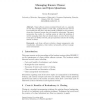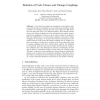AAAI
2010
14 years 9 months ago
2010
We consider the problem of manipulating elections via cloning candidates. In our model, a manipulator can replace each candidate c by one or more clones, i.e., new candidates that...
ORDER
2006
14 years 11 months ago
2006
The C-subfunction relations on the set of functions on a finite base set A defined by function classes C are examined. For certain clones C on A, it is determined whether the part...
JALC
2006
14 years 11 months ago
2006
Let A be a 2p-element set, p prime, and let be a fixed point-free permutation on A of order p. We study the interval of clones C on A such that C consists of functions that are s...
BMCBI
2007
14 years 11 months ago
2007
Background: Whereas the molecular assembly of protein expression clones is readily automated and routinely accomplished in high throughput, sequence verification of these clones i...
DAGSTUHL
2006
15 years 10 days ago
2006
Many software systems contained cloned code, i.e., segments of code that are highly similar to each other, typically because one has been copied from the other, and then possibly m...
CASCON
2004
15 years 10 days ago
2004
Previous research shows that most software systems contain significant amounts of duplicated, or cloned, code. Some clones are exact duplicates of each other, while others differ ...
103
click to vote
ACMSE
2006
ACM
15 years 28 days ago
2006
ACM
A code clone represents a sequence of statements that are duplicated in multiple locations of a program. Clones often arise in source code as a result of multiple cut/paste operat...
100
click to vote
FASE
2006
Springer
15 years 2 months ago
2006
Springer
Abstract. Code clones have long been recognized as bad smells in software systems and are considered to cause maintenance problems during evolution. It is broadly assumed that the ...
SAS
2001
Springer
15 years 3 months ago
2001
Springer
Programs often have a lot of duplicated code, which makes both understanding and maintenance more difficult. This problem can be alleviated by detecting duplicated code, extracting...
MSR
2010
ACM
15 years 4 months ago
2010
ACM
—Clones are generally considered bad programming practice in software engineering folklore. They are identified as a bad smell and a major contributor to project maintenance dif...






